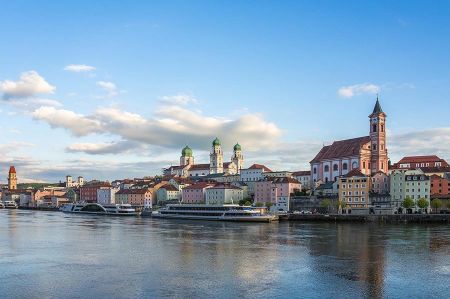Short city trip to Passau - the town shows signs of autumn
- Written by Portal Editor
We had already completed the already mentioned visit of our main sponsor and supporter Fendt-Caravan within the project "A journey of Intimacy and Culture along the Roman Roads" due to the upcoming TUV appointment and the gas prove of the project caravan, and fixed further intermediate targets for the return journey to the south.
So, after an invitation from Horst, we wanted to meet in the city of Kösslarn, and together move to further intermediate stations (here Passau) to the formation of the emerging camper route to the south with offers for outdoor activities and to stay during the winter. During the spring time, we met with Horst on Cyprus, who runs a travel agency and an online portal on hiking in Kösslarn, for inspecting new itineraries, f. e. the Besparmak Trail on Northern Cyprus.
City tour of Passau - on the Danube Peninsula
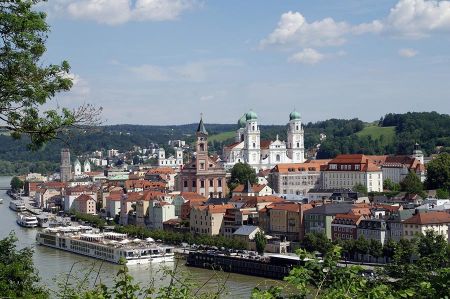 After a warm welcome, a welcome coffee and first talks, we also laid out an initially rough time frame for our stay in Kösslarn.
After a warm welcome, a welcome coffee and first talks, we also laid out an initially rough time frame for our stay in Kösslarn.
Thus, the visit of the city of Passau was planned, including, of course, the museum "Roman Museum Boiotro", which corresponded to the project management.
This is followed by another article a little later. In spite of light rain but dark cloudy sky, it should already be the next morning leaving to Passau. Horst had chosen a route on the peninsula between the Danube and the Inn, which would at least give a first rough overview of the city.
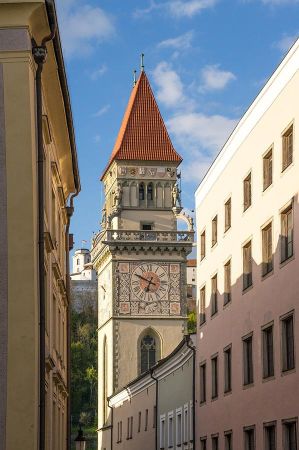 The city of Passau lies at the confluence of the three rivers Danube, Inn and Ilz. Due to the confluence of the water-rich rivers Danube and Inn, there is quite a lot moisture all around, so that there is often fog to be noticed in Passau.
The city of Passau lies at the confluence of the three rivers Danube, Inn and Ilz. Due to the confluence of the water-rich rivers Danube and Inn, there is quite a lot moisture all around, so that there is often fog to be noticed in Passau.
One of the major problems facing the city is the recurring floods, which have led to floods of the riverbank and many people have already left the town. Horst's acquaintances had also decided to leave after being flooded twice. If one looks at the various fixed marks for the water level, one can easily imagine such consequences.
In 1954 a devastating flood sought the city of Passau. A pronounced Vb weather situation caused a profitable land reign in Bavaria. A Vb weather (pronounced "Five-B weather", V = Roman 5) is characterized by the trajectory of a gravure area from Italy across the Po Valley or Northadria northeastward.
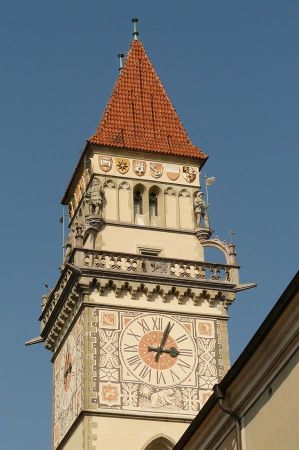 The air stream known as "Vb" was declared by Wilhelm Jacob van Bebber in 1891 and integrated with this notation into the system of large weather conditions. The resulting flood, also known as century-high water, was the largest flood catastrophe in Passau in the 20th century. The Danube reached a peak of 12.2 meters on 10 July 1954, 10.1 meters at the Inn and 12.15 meters at the Ilz. The district of Ilzstadt was hit hardest by this flood event, so several buildings stood under water for several days up to the first floor.
The air stream known as "Vb" was declared by Wilhelm Jacob van Bebber in 1891 and integrated with this notation into the system of large weather conditions. The resulting flood, also known as century-high water, was the largest flood catastrophe in Passau in the 20th century. The Danube reached a peak of 12.2 meters on 10 July 1954, 10.1 meters at the Inn and 12.15 meters at the Ilz. The district of Ilzstadt was hit hardest by this flood event, so several buildings stood under water for several days up to the first floor.
Under the influence of the massive damage of 1954, the first major closed measure of this type in Germany was implemented in flood protection in the district of Ilzstadt, which suffered the most damage during this flood event. Within the framework of the construction work, all buildings exposed to high water pollution were torn down and 60 of the 28 buildings were rebuilt on a shattered level. In addition, a concrete fortification was built for Ilz and the Danube, which serves as a substructure for a four-lane road. Replacement buildings in the higher Grubweg were created for the remaining properties. About half of the population in the district had to change housing.
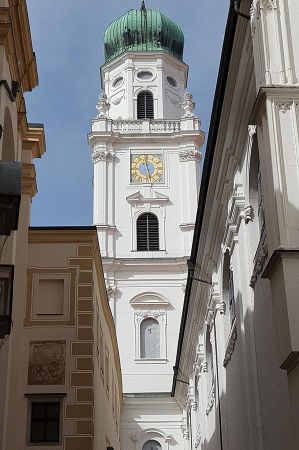 In the months of May and June of 2013, the city was one of the most serious floods in five hundred years, when the historic mark of 12.89 m was reached as the highest level of Passau / Danube.
In the months of May and June of 2013, the city was one of the most serious floods in five hundred years, when the historic mark of 12.89 m was reached as the highest level of Passau / Danube.
The drinking water supply had to be temporarily stopped, at schools and at the university the teaching completely stopped.
During and especially after the flood catastrophe the dedicated help of Passau by university students has to be mentioned.
The Facebook initiative "Passau admits", which was founded and managed by the students, was awarded the German Citizens' Prize in 2013.
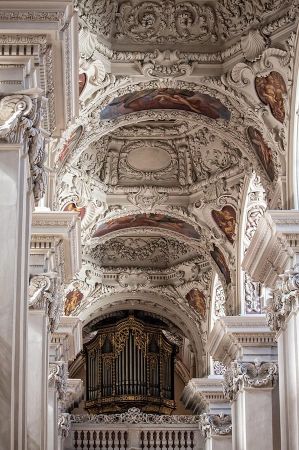 Passau passed its 50,000-inhabitants mark in 1993 and was elevated to an upper group of the Danube-Forest planning region.
Passau passed its 50,000-inhabitants mark in 1993 and was elevated to an upper group of the Danube-Forest planning region.
After the Dreiländerhalle was put into operation at the turn of the year 2003/2004, the Nibelungenhalle was demolished in the spring of 2004, and the planning of the new center began.
In the mid-1990s, an extensive urban redevelopment project was initiated, which, in addition to a shopping center, included an office tower, the "Central Omnibus Station" (ZOB) and the creation of a park.
After several drafts were being discussed, the construction activities for the creation of the New Center were finally completed.
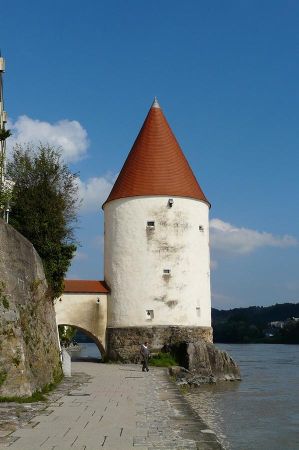 This urban redevelopment was a major change in the urban landscape. At the end of the 2000s, the last building works were completed.
This urban redevelopment was a major change in the urban landscape. At the end of the 2000s, the last building works were completed.
Horst provides many further explanations of the city and its history, shows us striking buildings and takes us through the narrow streets of the old town. Despite the uncomfortable weather a tour, which should be repeated in the sunshine.
Please read as well:
Regensburg Festival of German-Turkish Literature
Sepp Bögl - the stone-stacker from Lake Constance
-
 Passau - Seightseeing at Danube & Inn
Passau - Seightseeing at Danube & Inn
Passau - Seightseeing at Danube & Inn
Passau - Seightseeing at Danube & Inn
-
 Passau - Seightseeing at Danube & Inn
Passau - Seightseeing at Danube & Inn
Passau - Seightseeing at Danube & Inn
Passau - Seightseeing at Danube & Inn
-
 Passau - Seightseeing at Danube & Inn
Passau - Seightseeing at Danube & Inn
Passau - Seightseeing at Danube & Inn
Passau - Seightseeing at Danube & Inn
-
 Passau - Seightseeing at Danube & Inn
Passau - Seightseeing at Danube & Inn
Passau - Seightseeing at Danube & Inn
Passau - Seightseeing at Danube & Inn
-
 Passau - Seightseeing at Danube & Inn
Passau - Seightseeing at Danube & Inn
Passau - Seightseeing at Danube & Inn
Passau - Seightseeing at Danube & Inn
-
 Passau - Seightseeing at Danube & Inn
Passau - Seightseeing at Danube & Inn
Passau - Seightseeing at Danube & Inn
Passau - Seightseeing at Danube & Inn
-
 Passau - Seightseeing at Danube & Inn
Passau - Seightseeing at Danube & Inn
Passau - Seightseeing at Danube & Inn
Passau - Seightseeing at Danube & Inn
-
 Passau - Seightseeing at Danube & Inn
Passau - Seightseeing at Danube & Inn
Passau - Seightseeing at Danube & Inn
Passau - Seightseeing at Danube & Inn
-
 Passau - Seightseeing at Danube & Inn
Passau - Seightseeing at Danube & Inn
Passau - Seightseeing at Danube & Inn
Passau - Seightseeing at Danube & Inn
-
 Passau - Seightseeing at Danube & Inn
Passau - Seightseeing at Danube & Inn
Passau - Seightseeing at Danube & Inn
Passau - Seightseeing at Danube & Inn
-
 Passau - Seightseeing at Danube & Inn
Passau - Seightseeing at Danube & Inn
Passau - Seightseeing at Danube & Inn
Passau - Seightseeing at Danube & Inn
-
 Passau - Seightseeing at Danube & Inn
Passau - Seightseeing at Danube & Inn
Passau - Seightseeing at Danube & Inn
Passau - Seightseeing at Danube & Inn
-
 Passau - Seightseeing at Danube & Inn
Passau - Seightseeing at Danube & Inn
Passau - Seightseeing at Danube & Inn
Passau - Seightseeing at Danube & Inn
-
 Passau - Seightseeing at Danube & Inn
Passau - Seightseeing at Danube & Inn
Passau - Seightseeing at Danube & Inn
Passau - Seightseeing at Danube & Inn
-
 Passau - Seightseeing at Danube & Inn
Passau - Seightseeing at Danube & Inn
Passau - Seightseeing at Danube & Inn
Passau - Seightseeing at Danube & Inn
-
 Passau - Seightseeing at Danube & Inn
Passau - Seightseeing at Danube & Inn
Passau - Seightseeing at Danube & Inn
Passau - Seightseeing at Danube & Inn
-
 Passau - Seightseeing at Danube & Inn
Passau - Seightseeing at Danube & Inn
Passau - Seightseeing at Danube & Inn
Passau - Seightseeing at Danube & Inn
-
 Passau - Seightseeing at Danube & Inn
Passau - Seightseeing at Danube & Inn
Passau - Seightseeing at Danube & Inn
Passau - Seightseeing at Danube & Inn
-
 Passau - Seightseeing at Danube & Inn
Passau - Seightseeing at Danube & Inn
Passau - Seightseeing at Danube & Inn
Passau - Seightseeing at Danube & Inn
-
 Passau - Seightseeing at Danube & Inn
Passau - Seightseeing at Danube & Inn
Passau - Seightseeing at Danube & Inn
Passau - Seightseeing at Danube & Inn
-
 Passau - Seightseeing at Danube & Inn
Passau - Seightseeing at Danube & Inn
Passau - Seightseeing at Danube & Inn
Passau - Seightseeing at Danube & Inn
-
 Passau - Seightseeing at Danube & Inn
Passau - Seightseeing at Danube & Inn
Passau - Seightseeing at Danube & Inn
Passau - Seightseeing at Danube & Inn
-
 Passau - Seightseeing at Danube & Inn
Passau - Seightseeing at Danube & Inn
Passau - Seightseeing at Danube & Inn
Passau - Seightseeing at Danube & Inn
-
 Passau - Seightseeing at Danube & Inn
Passau - Seightseeing at Danube & Inn
Passau - Seightseeing at Danube & Inn
Passau - Seightseeing at Danube & Inn
https://www.alaturka.info/en/germany/bavaria/3495-short-city-trip-to-passau-the-town-shows-signs-of-autumn#sigProIded804c2054
